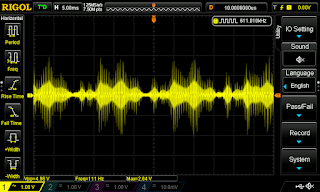Last night I joined the weekly
Macedon Ranges Amateur Radio Club 80m net on 3685 for a chat with the group. I called in as usual and was acknowledged. Net controller Joe commented that my signal was a bit down but I was fully readable.
After my first over I had a look and noticed that my transmitter was transmitting just 2% of the normal 100W as I'd been using it for WSPR earlier in the day! Despite this, everyone could hear me, including Peter, VK3RV, who was operating from South Australia.
Note also, that there was a very high level of noise from remote lightning happening in NSW.
I'm fortunate to have the nice dead tree you see here as the central support for my dipoles. The 80m dipole was raised with the generous assistance of Dallas, VK3EB, shortly after I moved to this location. The ends of the dipole are quite slack and have survived quite high winds over two years. (One end did come down on one occasion).
The 80m dipole slowly moves lower in resonance due to wire stretching so I pull it down periodically and fold back the ends a bit to move it up again.
I've used trap dipoles, G5RVs, off centre fed dipoles, and loops in the past with good results but I find plain old single band half wave dipoles work the best for me. I now have separate dipoles up for 80, 40, 20, and 10 meters.
When not in the shack I leave WSPR running so I can take a look at band conditions. At the moment I'm running a QDX from QRP-Labs. This runs under 4W but is heard around the globe. I've noted in the past that transmissions from the QDX are especially pure as they are not mixed audio and seem to be very well decoded.
Here's a transmission on 20m just now with 25 decodes in one over. Amazing for a transceiver that fits in a shirt pocket.
Later I was spotted by 72 stations in one transmission:
A simple but decent home brew dipole makes more difference than any fancy gear or additional power.
























